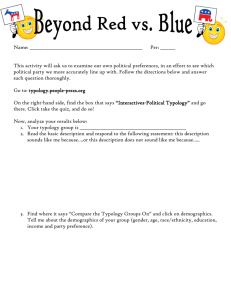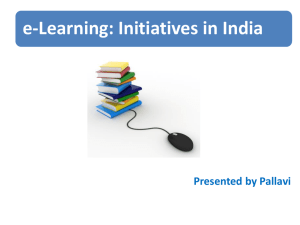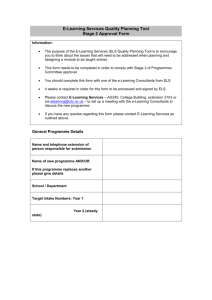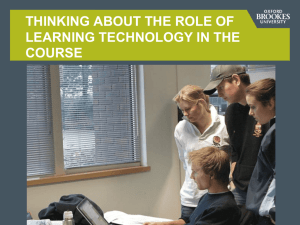Planning and Evaluating Effective Practice with e
advertisement
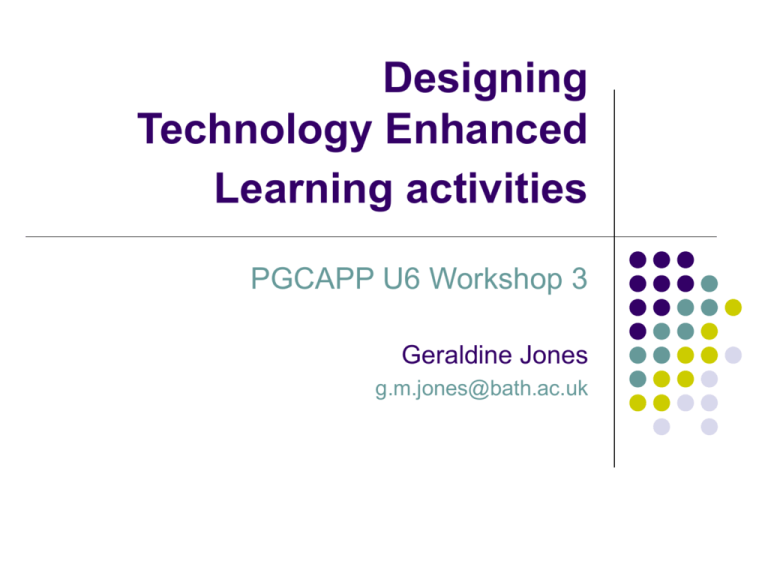
Designing Technology Enhanced Learning activities PGCAPP U6 Workshop 3 Geraldine Jones g.m.jones@bath.ac.uk Outline 1. 2. 3. 4. 5. How do people learn? Review of the place of learning theory in activity design. What helps people learn more effectively? Principles of effective pedagogic design. What works in practice? – Case study analysis. What does the technology contribute? Typology of technologies for learning. Examples Lecture Capture, Moodle for Peer assessment. How can I approach the design of technology enabled activities? Design task with JISC effective practice planner. 1. How do people learn? Three approaches to understanding learning Three (and a half) approaches to understanding learning People learn by association: building ideas or skills step-by-step e.g. mnemonics, training drills, imitation, instruction associative learning leads to accurate reproduction or recall People learn by constructing ideas and skills through active discovery e.g. exploration, experimentation, guided discovery, problem-solving, reflection constructive learning leads to integrated skills and deep understanding People learn by constructing ideas and skills through dialogue e.g. discussion, debate, collaboration, shared knowledge-building social constructive learning also leads to integrated skills and deep understanding People learn by participating in communities of practice e.g. apprenticeship, work-based learning, legitimate peripheral participation situated practice leads to the development of habits, values and identities Three broad approaches cont. All approaches emphasise: Learner activity Constructive alignment of activities with desired outcomes The importance of feedback Opportunities for consolidation (practice) and integration They differ in: The role and importance of other people The authenticity of the activity The formality of activity structures and sequences The emphasis on retention/reproduction or reflection/internalisation The locus of control Further resources Terry Mayes and Sara de Freitas (2004) Review of e-learning theories, frameworks and models JISC Effective Practice in a Digital Age: pages 10-11 Theory into Practice database http://tip.psychology.org/theories.html Theories of Learning – short paper from Oxford Brookes http://www.brookes.ac.uk/services/ocsd/2_learntch/theories.html 2. What helps people learn more effectively? Principles of effective pedagogic design Principles of effective learning design People learn more effectively when: They are active They are motivated and engaged Their existing capabilities are brought into play They are appropriately challenged zone of proximal development scaffolding differentiation They have opportunities for dialogue (with tutors, mentors or peers) They receive feedback (intrinsic or extrinsic) They have opportunities for consolidation and integration Outline of a learning activity Identities: preferences, needs, motivations Competences: skills, knowledge, abilities Roles: approaches and modes of participating learner(s) specific interaction of learner(s) with other(s), using specific tools and resources, oriented towards specific outcomes learning environment learning activity learning outcome(s) New knowledge, skills and abilities Artefacts of the activity process Feedback (intrinsic or extrinsic) Tools, resources, artefacts Affordances of the physical and virtual environment for learning other people Other people involved and the specific role they play in the interaction e.g. support, mediate, challenge, guide Further resources Effective Practice in a Digital Age: pages 12-13 Beetham, H. & Sharpe R. (2007) Rethinking Pedagogy in a Digital Age. Oxon:Routledge John Biggs (2003) Aligning teaching for constructive learning: available from the HE Academy resources database Activity - 1 3. What works in practice? Case study analysis Think about the following: Which learning theories are relevant? Which pedagogic principles are being used? Which activities help learners achieve which outcomes? How do the e-learning tools and resources support specific activities/outcomes? specific learners’ needs? Elements in learning design Problems Investigations Learning Projects Activity Tasks Role plays Tutorials, quizzes, Simulations, worksheets individual Learning Resources Teams, collaboration, Tutorials, conferences, Buddies, mentors group assessment Books, papers, Notes, web links, audio, Video, home study kits, Lectures, etc Schedules, instructions Procedures, announcements Learning Supports Modified after Oliver & Herrington, 2001 Further resources Littlejohn, A. & Pegler, C. (2007) Preparing for blended e-learning. Oxon:Routledge. Diana Laurillard (2003) Rethinking University Teaching 2nd Edition: Routledge 4. What does the technology contribute? Typology of technologies for learning. A typology of technologies for learning Based on Laurillard (1993, 2nd Edition 2003) Typology has been used to support design for learning e.g. Conole (2004); Littlejohn (2004); Warren and Mayer (2000) Expresses how technologies are used for learning Narrative = enabling representation of ideas Communicative = enabling dialogue between learners and others Interactive, Productive and Adaptive = enabling various forms of interactivity between learner(s) and the learning system Integrative (added category) = enabling integration of learning across activities The typology can be used to… Choose a technology type to support a specific learning activity or outcome Choose specific technologies within a type to suit learners’ ICT capabilities and skills to offer learners’ choice and autonomy e.g. over mode of access, approach to learning, medium used, adaptive technology… to support collaborative and peer learning (if appropriate) that is available, affordable and effectively supported Focus on technologies Lecture Capture Moodle tools for Peer Assessment Further resources Mason, R. & Rennie, F. (2008) E-learning and social networking handbook. Oxon:Routledge. 5. How can I approach the design of technology enabled activities? Design task with JISC effective practice planner. Tools for design JISC Planner – detailed analysis of context Oliver and Herrington LDS – description of a learning design. Activity 2 - Have a go …… Use the scenario provided or your own course to develop a technology enabled activity design. Where next…. Research and evaluation methods, including ethical considerations: – 1/12/10. Discuss your plans with your adviser Drafts of design proposal: 12/12/10


